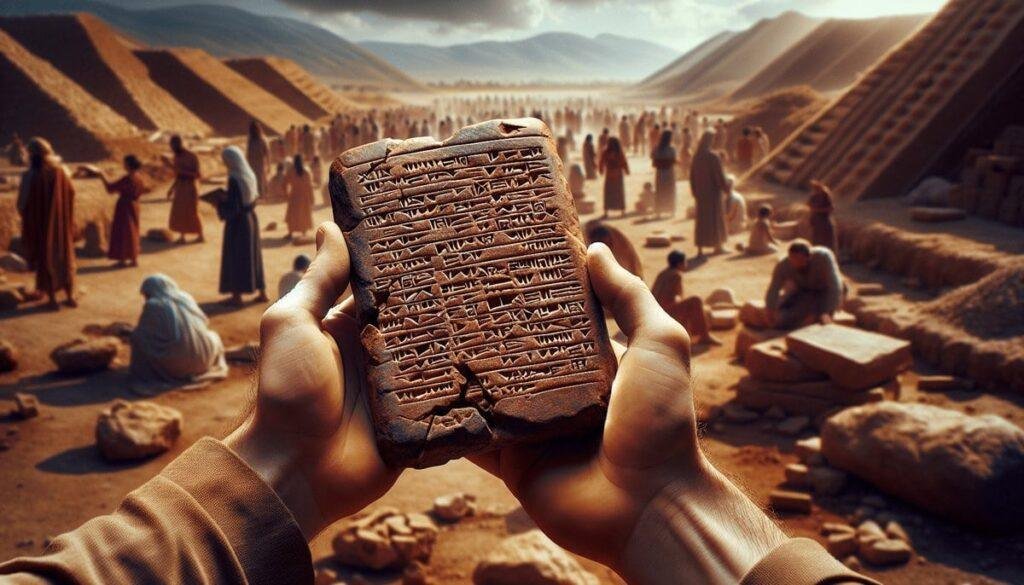Within the domain of biblical archaeology, 2023 revealed a compelling array of ancient relics that shed light on historical mysteries. From the unearthing of ancient scrolls in the Judean Desert to the discovery of rare biblical coins in Galilee, the year held a trove of surprises.
Inscriptions offering new insights into the New Covenant and gold artifacts possibly tied to the legendary King Solomon sparked intrigue. But perhaps most intriguing was the revelation of lost artifacts linked to the Exodus, hinting at a deeper connection to biblical narratives waiting to be uncovered.
Ancient Scrolls Uncovered in Judean Desert
During a recent excavation in the Judean Desert, ancient scrolls dating back to the Second Temple period were unearthed, revealing invaluable insights into Jewish life and beliefs. The Israel Antiquities Authority (IAA) led the operation, unearthing a treasure trove of historical manuscripts. Among the discoveries were fragments of biblical texts, including portions of the Book of Zechariah. These scrolls offer a rare glimpse into the religious practices and cultural norms of the ancient Jewish community, providing scholars with a deeper understanding of this pivotal period in history.
The unearthing of these ancient scrolls is significant not only for their historical value but also for their theological implications. The presence of biblical texts among the findings underscores the strong religious foundation of the Jewish people during the Second Temple period. The discovery of fragments from the Book of Zechariah, a prophetic book that holds great importance in Jewish scripture, adds a layer of complexity to our understanding of the religious beliefs and practices of the time.
Rare Biblical Coins Discovered in Galilee
Rare biblical coins from the time of Jesus were unearthed in Galilee in 2023, including a silver shekel and a half-shekel minted during the Jewish Revolt against Rome in 66/67 CE. These remarkable discoveries provide invaluable insights into the historical and cultural context of the region during that period.
Here is why these coins are of significant historical importance:
- Evidence of Jewish Revolt: The minting of these coins during the Jewish Revolt against Rome highlights the tumultuous times and the spirit of resistance among the Jewish population in Galilee.
- Economic Significance: The presence of these silver shekels and half-shekels underscores the economic transactions and trade that were prevalent in Galilee during the time of Jesus. They offer a tangible link to the economic activities of the ancient Jewish community.
- Cultural and Religious Context: These coins not only serve as artifacts of monetary value but also provide a glimpse into the religious practices and beliefs of the Jewish people in Galilee. They shed light on how religion and economy were intertwined in ancient Jewish society.
The discovery of these rare biblical coins enriches our understanding of the historical fabric of Galilee and adds to the broader collection of biblical artifacts that authenticate the narratives found in historical records and the Bible.
Inscriptions Revealing New Testament Insights
Revealing a lead tablet with a disputed Hebrew inscription in 2023 has sparked scholarly debates and raised questions about its potential insights into the New Covenant. The discovery of this intriguing artifact in Jerusalem, near significant biblical sites like the Temple Mount and the Pool of Siloam, has captured the attention of experts in biblical archaeology. Yiftah Shalev, a renowned archaeologist specializing in the First Temple period, has been at the forefront of analyzing this enigmatic find.
The controversial Hebrew inscription on the lead tablet has ignited a storm of controversy within the academic community, with experts divided over its authenticity and implications. Some scholars believe that the inscription could shed new light on the historical context of the New Covenant, offering fresh perspectives on the events and figures of that era. However, others remain skeptical, questioning the provenance and meaning of the inscription.
As researchers plumb deeper into the mysteries surrounding this lead tablet, the debates continue to intensify. The potential for this artifact to provide valuable insights into the narratives of the New Covenant has spurred further investigation and scrutiny. The implications of this discovery may reshape our understanding of the religious and cultural landscape during the time of the New Covenant.
Gold Artifacts Linked to King Solomon
Gold artifacts, including a medallion, two earrings, and a ring, discovered in Jerusalem in 2023 have been linked to King Solomon, providing tangible archaeological evidence supporting the biblical narratives of his reign. These artifacts, found in a sealed pottery vessel within a structure dating back to the 10th century B.C., offer a glimpse into the opulence and skilled craftsmanship of the ancient kingdom of Israel under King Solomon.
Key Points:
- Discovery in Jerusalem: The gold artifacts were unearthed in Jerusalem, a city rich in historical and biblical significance, adding another layer to its storied past.
- Royal Connection to King Solomon: The artifacts are believed to have belonged to King Solomon, a key figure in biblical history known for his wisdom and wealth, aligning with the descriptions of his grandeur in biblical texts.
- Archaeological Corroboration: This discovery provides concrete archaeological support for the existence and reign of King Solomon, reinforcing the historical accuracy of the biblical depictions of his era. The intricate designs and precious materials used in these artifacts highlight the prosperity and advanced metallurgical techniques of the ancient Israelites under King Solomon's rule.
The unearthing of these gold artifacts not only enriches our understanding of King Solomon's reign but also underscores the intricate connections between archaeology, history, and the biblical accounts of the ancient world.
Unearthing Lost Artifacts From Exodus
The recent unearthing of ancient Egyptian artifacts associated with the Exodus story, including chariot wheels and horse bones discovered at the bottom of the Red Sea, has sparked new insights into the potential evidence of the Israelites' escape from Egypt and their journey to the Promised Land. These discoveries provide tangible links to the biblical narrative of the Israelites' exodus from Egypt under the leadership of Moses. The recovery of such artifacts not only supports the historical accuracy of the Exodus account but also sheds light on the challenges faced by the Israelites during their escape.
| Archaeological Evidence | Implications |
|---|---|
| Chariot Wheels | Confirm biblical accounts of the pursuit by Egyptian chariots. |
| Horse Bones | Suggests the presence of Egyptian military forces during the Exodus. |
| Red Sea Artifacts | Reinforces the narrative of the miraculous parting of the Red Sea. |
| Exodus Journey Traces | Provides insights into the route taken by the Israelites. |
| Historical Validation | Strengthens the authenticity of the Exodus story. |
These findings not only enrich our understanding of the ancient events but also highlight the significance of archaeological evidence in verifying historical accounts. As further excavations continue in sites like the City of David, biblical Jerusalem, and other ancient cities, more treasures that illuminate the past are likely to surface, offering a glimpse into the lives of those who shaped history.


